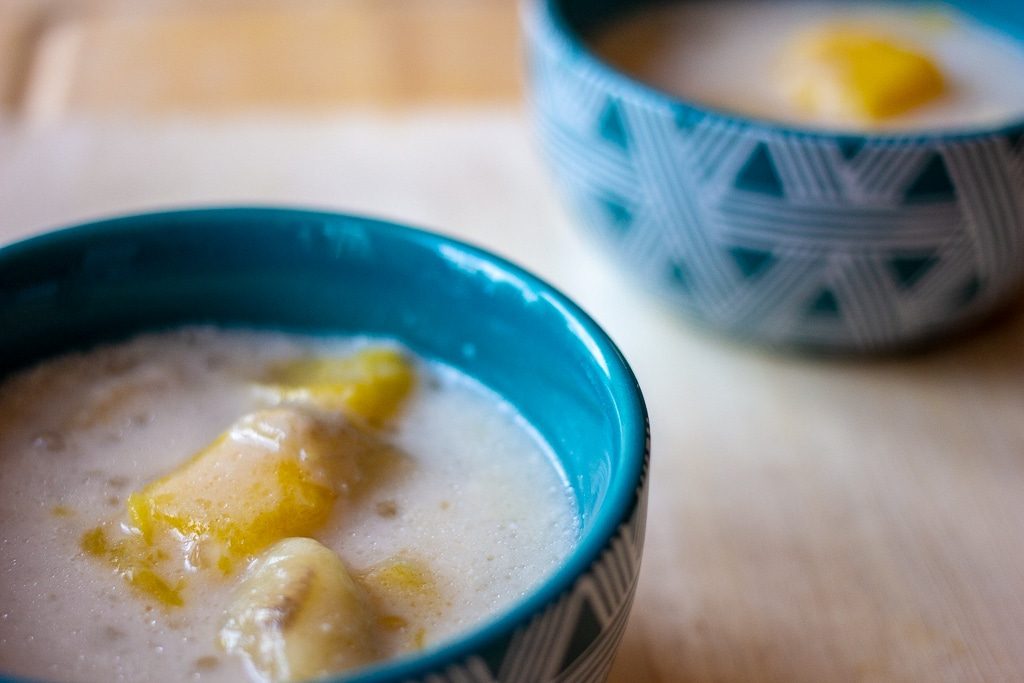 Pengat pisang is a classic, Malaysian dessert and is easy to make. Our version of this creamy and maybe indulgent dessert comes with a surprise ingredient.
Pengat pisang is a classic, Malaysian dessert and is easy to make. Our version of this creamy and maybe indulgent dessert comes with a surprise ingredient.
Our pengat pisang recipe is quick to make and features sago, a wonderful ingredient which helps thicken this creamy, slightly sweet dessert featuring banana and mango. Pengat pisang (banana) is a dessert you will find throughout Malaysia. It’s a creamy combination of fruit that is a little sweet without being over the top, thanks to the use of coconut milk.
It has a porridge like consistency and depending how much sago you use it can be thicker or thinner. The fruit set in the mixture with the fruit forming a great combination with the coconut milk. And, you can enjoy it warm or cold.
 Pengat pisang is just one of many dessert options awaiting you in Malaysia. Desserts in Malaysia are quite diverse because of the many cultural influences from around the region, as well as from colonial powers. Expect to see plenty of jellies (actually glutinous rice), cakes and slices. Desserts found throughout Malaysia can also be colorful! It’s also a great destination to try high tea with all the trimmings, in no small part because of the colonial traditions of years past.
Pengat pisang is just one of many dessert options awaiting you in Malaysia. Desserts in Malaysia are quite diverse because of the many cultural influences from around the region, as well as from colonial powers. Expect to see plenty of jellies (actually glutinous rice), cakes and slices. Desserts found throughout Malaysia can also be colorful! It’s also a great destination to try high tea with all the trimmings, in no small part because of the colonial traditions of years past.
Malaysian desserts are likely different to what you might be used to but there are some sweet delights on offer. We briefly describe some of our favorites, following our travels in Kuala Lumpur and Penang. What makes desserts in Malaysia so interesting are some of the ingredients commonly used to make these sweet delights. Fruit-based desserts are extremely popular, many of wiich are freely available throughout the world. Some of those ingredients are exotic but I am pleased to say, many of them are appearing throughout many places in the world.
I briefly describe some of the more common ingredients. Read on to find out more about Malaysian desserts.
Desserts in Malaysian Cuisine
What a natural balance there is between the sometimes fiery, Malaysian cuisine for savory dishes versus the sweet treats on offer as Malaysian desserts. Malaysian desserts are something you can look forward to for putting out the fire if you have eaten too much hot food! Although, many Malaysian desserts feature spices such as cinnamon and nutmeg.
PLANNING AN UPCOMING
DINNER PARTY?
Get a FREE copy of the ITALIAN
DINNER PARTY MENU, complete with recipes!
While many South East Asian savory dishes might be quite well known throughout the West, the same, perhaps, cannot be said for desserts. Well, with the exception of banana fritters!
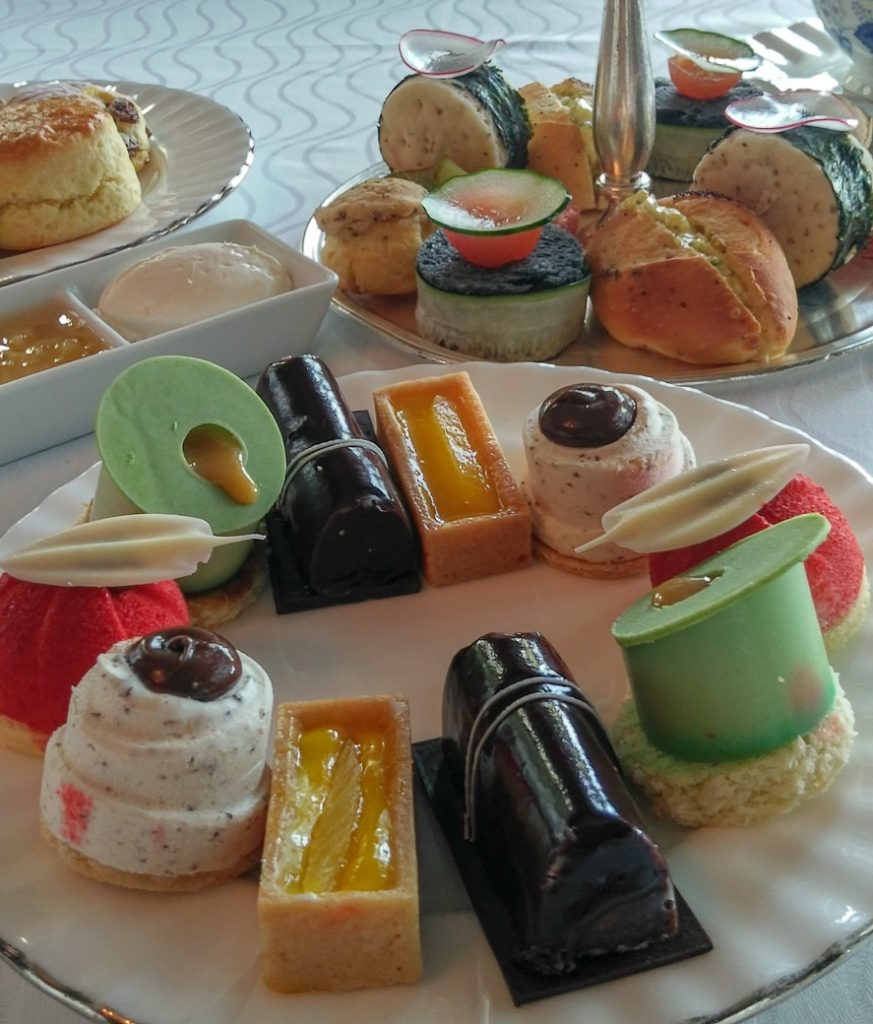
Experiencing the many cultural influences on the food is one of the great reasons to visit Malaysia. Desserts are diverse from high tea in Penang through to street food desserts, available everywhere it seems. Some of our favorites included:
Ais Kacang. It can also be known as ABC (air batu compu). It’s a concoction of jellies, cream corn, sweet red beans as a base. Sometimes there can be ground peanuts and nutmeg. But then the fun really starts. That’s all topped with shaved ice, drizzled with syrup, palm sugar and evaporated milk. The exact combination varies throughout the country but you get the picture. Make sure you try one, it is a Malay delicacy.
Cendol. With some of the same flavorings as for Ais Kacang, cendol will revive you if you need a little sweet pick me up at any time of the day. Delicious green strands made from flour and flavored by pandan leaves during their cooking, glutinous rice and served with many of the same ingredients noted above.
Moon Cake. To celebrate the Chinese Mid-Autumn or Moon Cake Festival. The moon cake is a traditional pastry, shaped to resemble the full moon. The moon cakes can be filled with traditional fillings such as red bean or lotus paste. Or you can go for the more modern ingredients such as chocolate, custard or even coffee! As well, there are a host of other, potential ingredients I haven’t mentioned.
Bubur Cha Cha. A Nyonya-style favorite in Malaysia. Another common type of dessert is to use “vegetables as fruits”. It never ceases to amaze me how good vegetables like sweet potato and yams can be when treated as fruits and cooked for dessert. Think of this dessert as being like a sweet porridge. It’s a delicious combination of thick coconut milk, sugar, sago and pandan leaves. You can eat it warm or cold.
Malay Dessert Ingredients
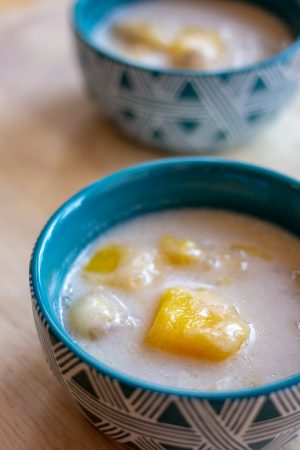 I’ve mentioned some common dessert ingredients used in Malay cooking. It’s time to talk about a few of them in more detail.
I’ve mentioned some common dessert ingredients used in Malay cooking. It’s time to talk about a few of them in more detail.
Palm sugar. In Malaysia, our pengat pisang recipe would be made with palm sugar. It’s made from the sap of coconut palms and is usually sold in cakes or tubes. Similar to brown sugar. It is commonly used with pandan leaves.
Pandan leaves. They are a natural flavoring used to add fragrance and color in desserts and some savory dishes. They are usually crushed or bruised and added towards the end of the cooking process.
Sago. Sago is a starch extracted from palm stems. Malaysia is a major producer of sago. Sago pearls will thicken the liquids they are cooked in.
Coconut Milk and Coconut Cream. They are both very commonly used in Malaysian desserts.
If you want to take some of the mystery out of shopping for ingredients like these, we have a free Asian Ingredients guide, complete with pictures. Now, we can use the ingredients featured here in our pengat pisang recipe.
Pengat Pisang Recipe: Banana in Coconut Milk with Mango
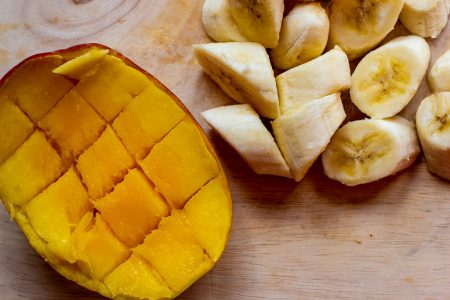 This is a very simple recipe but there are just a few things to be aware of. The sago is a thickening agent and you can vary how thick or thin the mixture is. So, don’t be too concerned about being exact with measurements.
This is a very simple recipe but there are just a few things to be aware of. The sago is a thickening agent and you can vary how thick or thin the mixture is. So, don’t be too concerned about being exact with measurements.
In Malaysia, the sweetening agent of choice is to use palm sugar, rather than brown sugar but I think brown sugar is just fine.
The pandan leaves provide fragrance and color and the dish is the better for using it. You will find pandan leaves at Asian supermarkets and better supermarkets.
| Servings | Prep Time | Cook Time |
| 4serves | 10minutes | 20minutes |
| Servings | Prep Time |
| 4serves | 10minutes |
| Cook Time |
| 20minutes |
- 2 tbsp sago soaked
- 3 bananas sliced diagonally
- 1 mango cubed
- 1 cup coconut milk
- 2 cups water
- 1 pandan leaf knotted, optional
- 1/2 tsp salt, ground sea
- 1/4 cup sugar, brown or palm sugar
|
Ingredients
Servings: serves
Units:
|
- Soak the sago in water for 10 minutes. Cut the bananas into 1/2 inch (1.5cm) diagonal slices. and the mango into 1/2 inch (1.5cm) cubes.
- Place the coconut milk, water, pandan leaf (if using), in a saucepan and bring to a boil. Add soaked sago, salt and brown sugar and simmer until it becomes transparent, about 5 minutes.
- Add sliced bananas, stirring gently to combine, simmer 3 minutes, then add the mangoes. Simmer a further 2 minutes. The mixture will thicken. Remove from the heat. Serve either hot or cold.

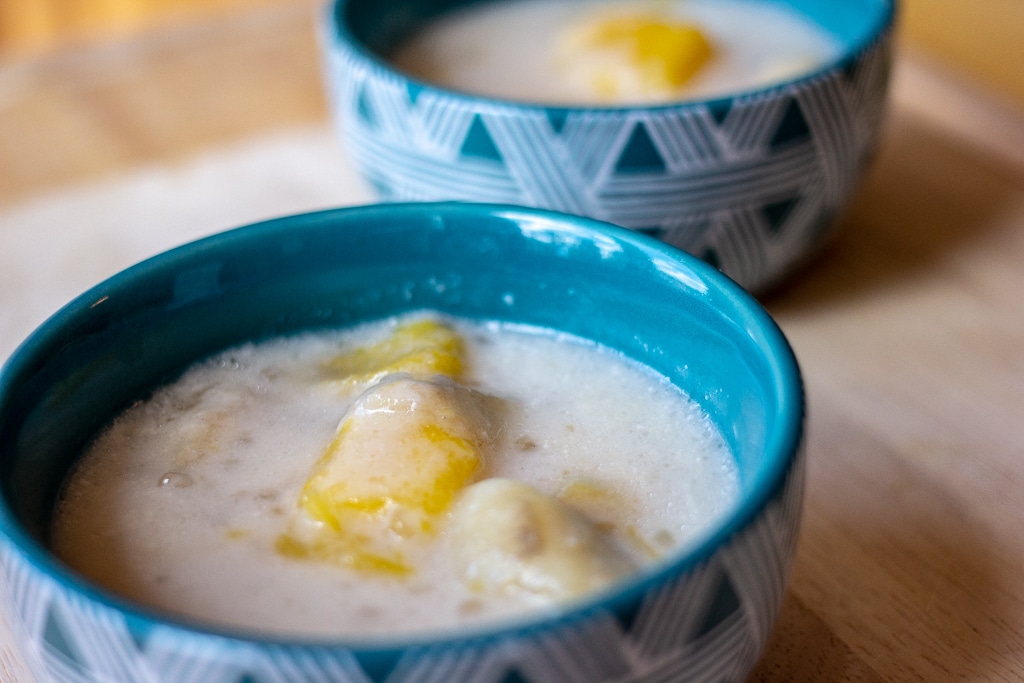
Leave a Reply